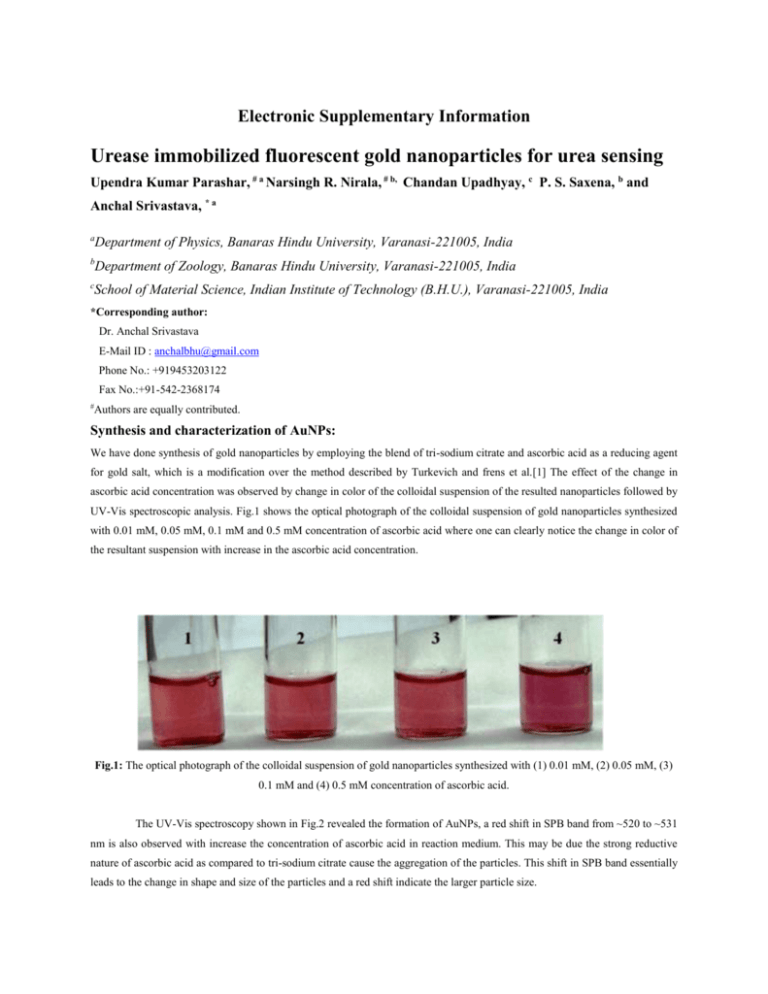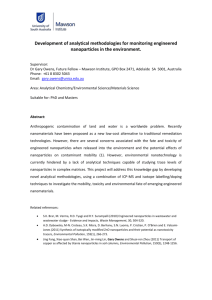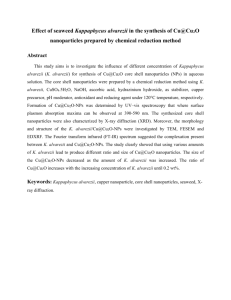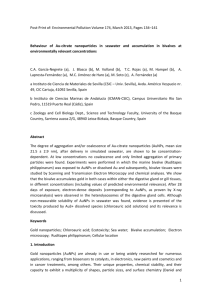Urease immobilized fluorescent gold nanoparticles for urea sensing
advertisement

Electronic Supplementary Information Urease immobilized fluorescent gold nanoparticles for urea sensing Upendra Kumar Parashar, # a Narsingh R. Nirala, # b, Chandan Upadhyay, c P. S. Saxena, b and Anchal Srivastava, * a a Department of Physics, Banaras Hindu University, Varanasi-221005, India b Department of Zoology, Banaras Hindu University, Varanasi-221005, India c School of Material Science, Indian Institute of Technology (B.H.U.), Varanasi-221005, India *Corresponding author: Dr. Anchal Srivastava E-Mail ID : anchalbhu@gmail.com Phone No.: +919453203122 Fax No.:+91-542-2368174 #Authors are equally contributed. Synthesis and characterization of AuNPs: We have done synthesis of gold nanoparticles by employing the blend of tri-sodium citrate and ascorbic acid as a reducing agent for gold salt, which is a modification over the method described by Turkevich and frens et al.[1] The effect of the change in ascorbic acid concentration was observed by change in color of the colloidal suspension of the resulted nanoparticles followed by UV-Vis spectroscopic analysis. Fig.1 shows the optical photograph of the colloidal suspension of gold nanoparticles synthesized with 0.01 mM, 0.05 mM, 0.1 mM and 0.5 mM concentration of ascorbic acid where one can clearly notice the change in color of the resultant suspension with increase in the ascorbic acid concentration. Fig.1: The optical photograph of the colloidal suspension of gold nanoparticles synthesized with (1) 0.01 mM, (2) 0.05 mM, (3) 0.1 mM and (4) 0.5 mM concentration of ascorbic acid. The UV-Vis spectroscopy shown in Fig.2 revealed the formation of AuNPs, a red shift in SPB band from ~520 to ~531 nm is also observed with increase the concentration of ascorbic acid in reaction medium. This may be due the strong reductive nature of ascorbic acid as compared to tri-sodium citrate cause the aggregation of the particles. This shift in SPB band essentially leads to the change in shape and size of the particles and a red shift indicate the larger particle size. Fig.2: The UV-Visible spectrograph of the colloidal suspension of gold nanoparticles synthesized with 0.01 mM, 0.05 mM, 0.1 mM and 0.5 mM concentration of ascorbic acid. The SEM micrograph shown in Fig.3 revealed the fine spherical nanoparticles formation in case of sample1 and 2,while in sample 3 particle get agglomerated at some places. The agglomeration at large scale can be seen in sample 4. This may be due to the variation of ascorbic acid concentration in the reaction media. The agglomeration and particle size distributions in the sample were also suggested by the shift and broadening of UV-Vis spectral peak in Fig.2. Both, microscopic and spectroscopic results/observations are well correlated. Fig.3: The SEM micrograph of the colloidal suspension of gold nanoparticles synthesized with 0.01 mM, 0.05 mM, 0.1 mM and 0.5 mM concentration of ascorbic acid. The XRD pattern of as synthesized material has been shown in Fig.4. The presence of peaks at 2θ values 38.63°, 44.8°, 64.56° and 77.52° corresponds to (111), (200), (220) and (311) planes of gold, respectively. Thus, the XRD spectrum confirmed the crystalline structure of gold. No peaks of other impurity crystalline phases have been detected. All the peaks in XRD pattern can be readily indexed to a face-centered cubic structure of gold as per available literature (JCPDS, File No. 4-0784). The lattice constant calculated from this pattern has been found to be a = 0.4320 nm, which is consistent with the standard value a = 0.4078 nm. The broadening of XRD peaks reveals the formation of nanoparticles. We have obtained the full width at half maxima (FWHM) for all identified XRD peaks by fitting the peaks with spectra calc software and the size of the nanoparticles was estimated by the using Scherrer formula 2: A= 0.94λ/βcosθ Where A is the crystallite size, is the full width at half maxima (FWHM) of the diffraction peak, (1.5405 Å) is the wavelength of X-ray radiation and is the angle of diffraction. For 2 values 38.63, 44.8, 64.56 and 77.52, the values are found to be 1.9049, 2.1728, 2.7105 and 2.2975 degree. The calculated average particle size from these values is about 4.25 nm. Inherent stress inside the nanocrystal could contribute to the broadening of XRD peaks. XRD pattern indicates the formation of pure AuNPs under current synthetic conditions. In order to distinguish the effect of crystallite size induced broadening and strain induced broadening at FWHM of XRD profile, Williamson-Hall plot 3 has been drawn which is shown in inset of Figure 5. The crystallite size and strain can be obtained from the intercept at y-axis and the slope of line, respectively. β cos θ =Kλ/d+ 2ε sin θ Where, β is FWHM in radian, d is the grain size in nm, ε is the strain, λ is X-ray wavelength in nanometers, and K is a correction factor taken as 0.94. The grain size and strain of the sample have been found to be 7.92 nm nm and 2.14 × 10-2, respectively. Fig.4: The XRD pattern of gold nanoparticles and inset shows the Williamson-Hall plot for the same. References: 1. 2. 3. J. Turkevich, P. C. Stevenson and J. Hillier, Discussions of the Faraday Society, 1951, 11, 55-75. H. P. A. Klug, Leroy E., X-Ray Diffraction Procedures: For Polycrystalline and Amorphous Materials, Wiley-VCH New York, 1974. G. K. Williamson and W. H. Hall, Acta Metallurgica, 1953, 1, 22-31.










